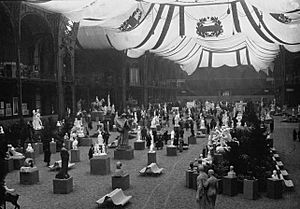Salon (Paris) facts for kids
The Salon was a very important art show in Paris, France. It started way back in 1667. For a long time, from 1748 to 1890, it was one of the biggest and most famous art events in the whole Western world. Many artists wanted their work to be shown there. Today, a group called the Société des Artistes Français manages it.
Contents
How the Salon Started
In 1667, a royal art group in France, called the Académie royale de peinture et de sculpture, held its first public art show. This show was in a special room at the Louvre Palace called the Salon Carré. The main goal of the Salon was to show off art from new students who had just finished their studies at the École des Beaux-Arts. This art school was started by Cardinal Mazarin in 1648.
For over 200 years, if an artist wanted to become famous in France, they absolutely had to show their art at the Salon. Being chosen to exhibit there meant the King liked your work.
In 1725, the Salon moved to the Louvre Palace permanently. That's when it became known simply as "the Salon" or "Salon de Paris." By 1737, the shows became open to everyone, not just a select few. They started happening every year, then every two years, always beginning on August 25th. Once the Salon became a regular public event, its importance was clear to everyone. In 1748, a group of famous artists started choosing which artworks would be shown. This made the Salon even more powerful.
The Salon's Golden Age (1748–1890)
The Salon was famous for showing paintings from the floor all the way up to the ceiling! Every tiny bit of wall space was covered with art. This crowded way of showing art even became the subject of other paintings.
Printed books listing all the artworks shown at the Salon are very helpful for art historians today. Also, the detailed descriptions of the shows, printed in newspapers, marked the beginning of what we now call "art criticism." This is when people started writing reviews about art.
After the French Revolution, artists from other countries were allowed to show their work too. In the 1800s, the idea of the Salon grew. It became a big yearly show, supported by the government, where new paintings and sculptures were judged. People could buy tickets to see the art in large halls.
The opening night, called the vernissage, was a huge social event. It was so crowded that newspaper cartoonists like Honoré Daumier often drew funny pictures about it. Famous writers like Charles Baudelaire and Denis Diderot even wrote reviews about the art at the Salons.
The revolution of 1848 made the Salon more open. Fewer artworks were rejected, and in 1849, artists could even win medals for their work.
New Art Groups Emerge
The judges at the Salon were becoming very traditional. They often didn't like the new style of painting called Impressionism. Impressionist paintings were usually rejected or placed in bad spots if they were accepted. The Salon didn't like how Impressionists moved away from old painting styles.
In 1857, the Salon jury turned away a lot of paintings. Many artists, especially those who usually showed their work, were very upset. To show that the Salons were fair, Napoléon III created a special show called the Salon des Refusés. This show displayed all the artworks that the main Salon had rejected that year. It opened on May 17, 1863, and it was a big moment for new, experimental art.
The Impressionists decided to hold their own art shows. They had independent exhibitions in 1874, 1876, 1877, 1879, 1880, 1881, 1882, and 1886.
In 1881, the government stopped officially supporting the Salon. So, a group of artists formed the Société des Artistes Français to take over running the show themselves.
The Salon Splits
In December 1890, the head of the Société des Artistes Français, William-Adolphe Bouguereau, suggested that the Salon should only show art from young artists who hadn't won awards yet. But famous artists like Ernest Meissonier, Puvis de Chavannes, and Auguste Rodin disagreed. They decided to leave and start their own group.
They created the Société Nationale des Beaux-Arts and held their own exhibition. The newspapers quickly called it the Salon du Champ de Mars or the Salon de la Société Nationale des Beaux–Arts. It soon became known simply as the Nationale.
Later, in 1903, many artists felt that the existing art organizations were too old-fashioned. So, a group of painters and sculptors, including Pierre-Auguste Renoir and Auguste Rodin, started another new show called the Salon d'Automne.
Images for kids
See also
 In Spanish: Salón de París para niños
In Spanish: Salón de París para niños








